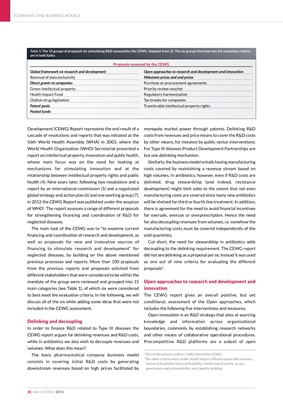
Development (CEWG) Report represents the end result of a
cascade of resolutions and reports that was initiated at the
56th World Health Assembly (WHA) in 2003, where the
World Health Organization (WHO) Secretariat presented a
report on intellectual property, innovation and public health,
whose main focus was on the need for looking at
mechanisms for stimulating innovation and at the
relationship between intellectual property rights and public
health (4). Nine years later, following two resolutions and a
report by an international commission (5) and a negotiated
global strategy and action plan (6) and one working group (7),
in 2012 the CEWG Report was published under the auspices
of WHO1. The report assesses a range of different proposals
for strengthening financing and coordination of R&D for
neglected diseases.
The main task of the CEWG was to "to examine current
financing and coordination of research and development, as
well as proposals for new and innovative sources of
financing to stimulate research and development" for
neglected diseases, by building on the above mentioned
previous processes and reports. More than 100 proposals
from the previous reports and proposals solicited from
different stakeholders that were considered to be within the
mandate of the group were reviewed and grouped into 15
main categories (see Table 1), of which six were considered
to best meet the evaluation criteria. In the following, we will
discuss all of the six while adding some ideas that were not
included in the CEWG assessment.
Delinking and decoupling
In order to finance R&D related to Type III diseases the
CEWG report argues for delinking revenues and R&D costs,
while in antibiotics we also wish to decouple revenues and
volumes. What does this mean?
The basic pharmaceutical company business model
consists in covering initial R&D costs by generating
downstream revenues based on high prices facilitated by
monopoly market power through patents. Delinking R&D
costs from revenues and price means to cover the R&D costs
by other means, for instance by public sector interventions.
For Type III diseases Product Development Partnerships are
but one delinking mechanism.
Similarly, the business model entails having manufacturing
costs covered by maintaining a revenue stream based on
high volumes. In antibiotics, however, even if R&D costs are
delinked, drug stewardship (and indeed, resistance
development) might limit sales to the extent that not even
manufacturing costs are covered since many new antibiotics
will be shelved for third or fourth line treatment. In addition,
there is agreement for the need to avoid financial incentives
for oversale, overuse or overprescription. Hence the need
for also decoupling revenues from volumes, i.e. somehow the
manufacturing costs must be covered independently of the
sold quantities.
Cut short, the need for stewardship in antibiotics adds
decoupling to the delinking requirement. The CEWG report
did not see delinking as a proposal per se; instead it was used
as one out of nine criteria for evaluating the different
proposals2.
Open approaches to research and development and
innovation
The CEWG report gives an overall positive, but yet
conditional, assessment of the Open approaches, which
includes the following five interventions and measures.
Open innovation is an R&D strategy that aims at sourcing
knowledge and information across organizational
boundaries, commonly by establishing research networks
and other means of collaborative operational procedures.
Precompetitive R&D platforms are a subset of open
ECONOMIC AND BUSINESS MODELS
20 AMR CONTROL 2015
Table 1: The 15 groups of proposals for stimulating R&D assessed by the CEWG. Adapted from (1). The six groups that best met the evaluation criteria
are in bold italics
Global framework on research and development
Removal of data exclusivity
Direct grants to companies
Green intellectual property
Health Impact Fund
Orphan drug legislation
Patent pools
Pooled funds
Open approaches to research and development and innovation
Milestone prizes and end prizes
Purchase or procurement agreements
Priority review voucher
Regulatory harmonization
Tax breaks for companies
Transferable intellectual property rights
Proposals assessed by the CEWG
1 One of the present authors (JAR) chaired the CEWG.
2 The other criteria were: public health impact, efficiency/cost effectiveness,
technical feasibility, financial feasibility, intellectual property, access,
governance and accountability, and capacity building.